
Macaws are a group of New World parrots that are long-tailed and often colorful. They are popular in aviculture or as companion parrots, although there are conservation concerns about several species in the wild.

Swarm behaviour, or swarming, is a collective behaviour exhibited by entities, particularly animals, of similar size which aggregate together, perhaps milling about the same spot or perhaps moving en masse or migrating in some direction. It is a highly interdisciplinary topic. As a term, swarming is applied particularly to insects, but can also be applied to any other entity or animal that exhibits swarm behaviour. The term flocking or murmuration can refer specifically to swarm behaviour in birds, herding to refer to swarm behaviour in tetrapods, and shoaling or schooling to refer to swarm behaviour in fish. Phytoplankton also gather in huge swarms called blooms, although these organisms are algae and are not self-propelled the way animals are. By extension, the term "swarm" is applied also to inanimate entities which exhibit parallel behaviours, as in a robot swarm, an earthquake swarm, or a swarm of stars.
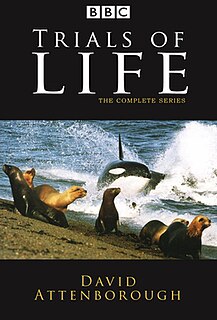
The Trials of Life: A Natural History of Behaviour is a BBC nature documentary series written and presented by David Attenborough, first transmitted in the United Kingdom from 3 October 1990.
Swarm intelligence (SI) is the collective behavior of decentralized, self-organized systems, natural or artificial. The concept is employed in work on artificial intelligence. The expression was introduced by Gerardo Beni and Jing Wang in 1989, in the context of cellular robotic systems.
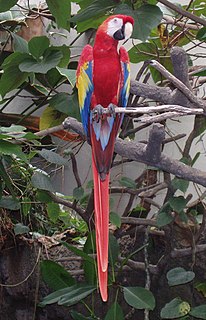
The scarlet macaw is a large red, yellow, and blue Central and South American parrot, a member of a large group of Neotropical parrots called macaws. It is native to humid evergreen forests of the Neotropics. Its range extends from south-eastern Mexico to Peru, Ecuador, Colombia, Bolivia, Venezuela and Brazil in lowlands of 500 m (1,600 ft) up to 1,000 m (3,300 ft), the Caribbean island of Trinidad, as well as the Pacific island of Coiba. Formerly, it ranged north to southern Tamaulipas. In some areas, it has suffered local extinction because of habitat destruction, or capture for the parrot trade, but in other areas, it remains fairly common. It is the national bird of Honduras. Like its relative the blue-and-yellow macaw, the scarlet macaw is a popular bird in aviculture as a result of its striking plumage.
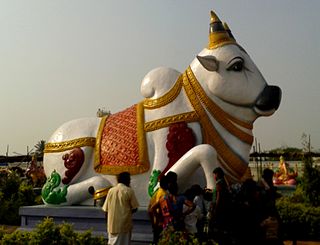
The term Animal worship is an umbrella term designating religious or ritual practices involving animals. This includes the worship of animal deities or animal sacrifice. An animal 'cult' is formed when a species is taken to represent a religious figure. Animal cults can be classified according to their formal features or by their symbolic content.
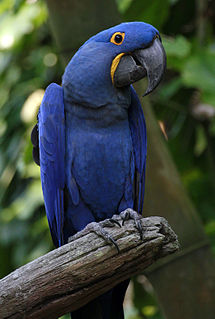
The hyacinth macaw, or hyacinthine macaw, is a parrot native to central and eastern South America. With a length of about one meter it is longer than any other species of parrot. It is the largest macaw and the largest flying parrot species; the flightless kākāpō of New Zealand outweighs it at up to 3.5 kg. While generally easily recognized, it could be confused with the smaller Lear's macaw. Habitat loss and the trapping of wild birds for the pet trade have taken a heavy toll on their population in the wild, so the species is classified as Vulnerable on the International Union for Conservation of Nature's Red List, and it is protected by its listing on Appendix I of the Convention on International Trade in Endangered Species of Wild Fauna and Flora (CITES).

Jeremy Narby is a Canadian anthropologist and author.

The Naturalist on the River Amazons, subtitled A Record of the Adventures, Habits of Animals, Sketches of Brazilian and Indian Life, and Aspects of Nature under the Equator, during Eleven Years of Travel, is an 1863 book by the British naturalist Henry Walter Bates about his expedition to the Amazon basin. Bates and his friend Alfred Russel Wallace set out to obtain new species and new evidence for evolution by natural selection, as well as exotic specimens to sell. He explored thousands of miles of the Amazon and its tributaries, and collected over 14,000 species, of which 8,000 were new to science. His observations of the coloration of butterflies led him to discover Batesian mimicry.
Comparative mythology is the comparison of myths from different cultures in an attempt to identify shared themes and characteristics. Comparative mythology has served a variety of academic purposes. For example, scholars have used the relationships between different myths to trace the development of religions and cultures, to propose common origins for myths from different cultures, and to support various psychoanalytical theories.

Loro Parque or 'Loro Park' is a 13.5-hectare (33-acre) zoo on the outskirts of Puerto de la Cruz on Tenerife, Spain where it houses an extensive and diverse reserve of animal and plant species. The park was conceived as a paradise for parrots and has developed over the years into one of the biggest attractions of the Canary Islands, with over 40 million visitors. The park keeps orcas, which has attracted criticism from some organisations.

Zoopharmacognosy is a behaviour in which non-human animals apparently self-medicate by selecting and ingesting or topically applying plants, soils, insects, and psychoactive drugs to prevent or reduce the harmful effects of pathogens and toxins. The term derives from Greek roots zoo ("animal"), pharmacon, and gnosy ("knowing").

The difficulty of defining or measuring intelligence in non-human animals makes the subject difficult to study scientifically in birds. In general, birds have relatively large brains compared to their head size. The visual and auditory senses are well developed in most species, though the tactile and olfactory senses are well realized only in a few groups. Birds communicate using visual signals as well as through the use of calls and song. The testing of intelligence in birds is therefore usually based on studying responses to sensory stimuli.

Parrots, also known as psittacines, are birds of the roughly 398 species in 92 genera comprising the order Psittaciformes, found mostly in tropical and subtropical regions. The order is subdivided into three superfamilies: the Psittacoidea, the Cacatuoidea (cockatoos), and the Strigopoidea. One-third of all parrot species are threatened by extinction, with higher aggregate extinction risk than any other comparable bird group. Parrots have a generally pantropical distribution with several species inhabiting temperate regions in the Southern Hemisphere, as well. The greatest diversity of parrots is in South America and Australasia.
The Manú Learning Centre (MLC) is located within the Fundo Mascoitania Reserve, a 643 hectare private nature reserve, encompassed within the cultural zone of the Manú Biosphere Reserve, a UNESCO World Heritage site and one of the largest protected areas in Peru. It is home to a variety of rainforest types including lowland Andean, pre-montane, bamboo and high terrace forests. This geographical complexity creates habitats for a diversity of flora and fauna. The MLC is operated by the CREES group, a non-profit and business collaboration working towards sustainability for the Manú Region. The MLC serves local schools and communities as well as international researchers and volunteers. It has hosted workshops for the Organization for Tropical Studies, and on behalf of the Manú National Park Guards, as well as research projects from the University of Oxford, Aberdeen, and Glasgow University in addition to the SOAS. The MLC has also worked alongside schools from the UK including Southbank International School and Tonbridge School.
Timothy Robert Birkhead is a British ornithologist. He has been Professor of Behaviour and Evolution at the University of Sheffield since 1976.

The Macaw Society is a long-term research project on the ecology and conservation of macaws and parrots under the direction of Donald Brightsmith and Gabriela Vigo of the Schubot Center for Avian Health at the Texas A&M University. The project has been working with wildlife and local communities since 1989. The long-term research and monitoring have provided many insights into various aspects of parrot and wildlife of south-eastern Peru. Macaws are among the most effective flagship species for ecosystem conservation in the Amazonian rainforest.

The Catalina macaw, sometimes known as the rainbow macaw is a first generation hybrid between the blue-and-gold macaw and scarlet macaw. As catalina macaws are hybrids, they do not have a true scientific name. The best way to represent these birds in taxonomy is by the expression Ara ararauna × Ara macao.

Other Minds is a 2016 bestseller by Peter Godfrey-Smith on the evolution and nature of consciousness. It compares the situation in cephalopods, especially octopuses and cuttlefish, with that in mammals and birds. Complex active bodies that enable and perhaps require a measure of intelligence have evolved three times, in arthropods, cephalopods, and vertebrates. The book reflects on the nature of cephalopod intelligence in particular, constrained by their short lifespan, and embodied in large part in their partly autonomous arms which contain more nerve cells than their brains.
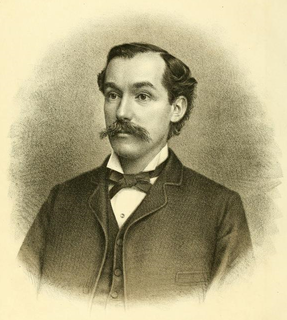
Thomas George Gentry was an American educator, ornithologist, naturalist and animal rights writer. Gentry authored an early work applying the term intelligence to plants.
















